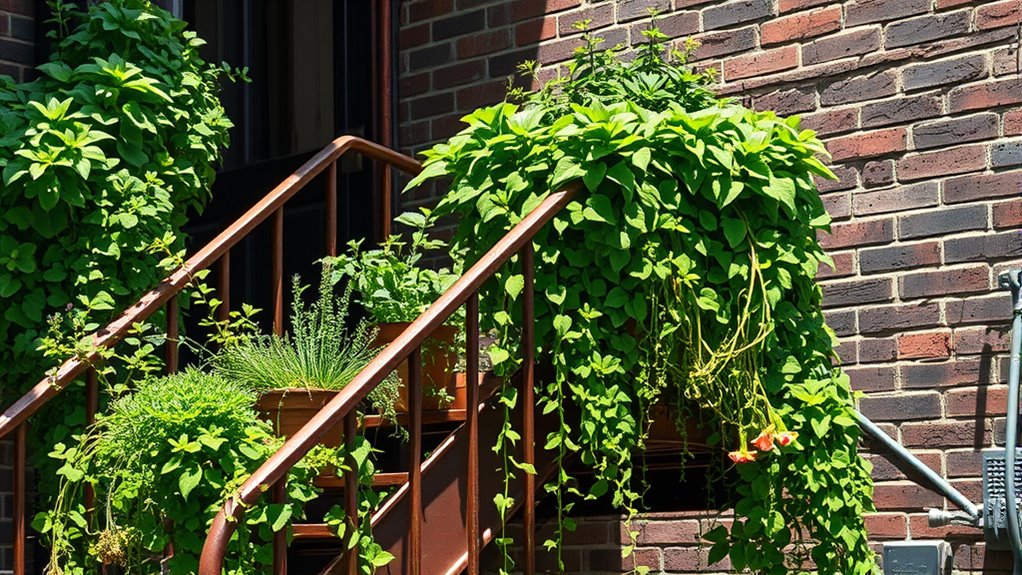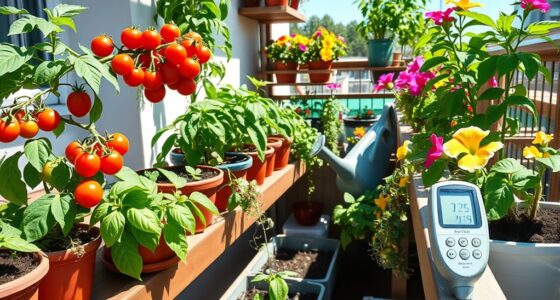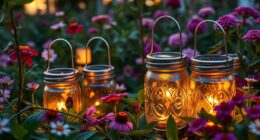To create a hidden garden on your fire escape, choose lightweight, weather-resistant containers that fit your space. Opt for plants like herbs, succulents, and small flowers that thrive in containers and require minimal soil. Incorporate nectar-rich flowers and seed-producing plants to attract pollinators and birds. Use creative arrangements to maximize sunlight and space, and consider adding bird feeders or water sources. Keep exploring for more tips to turn your fire escape into a lively mini-ecosystem.
Key Takeaways
- Use lightweight, weather-resistant containers that can be hung or stacked to maximize limited fire escape space.
- Choose low-maintenance, thriving plants like herbs, succulents, and small flowers suited for containers.
- Incorporate native or nectar-producing plants such as lavender or bee balm to attract pollinators and wildlife.
- Add bird-friendly elements like seed-producing plants, small water sources, or bird feeders to create a mini urban habitat.
- Arrange plants flexibly to optimize sunlight exposure and protect them from harsh weather conditions.

Creating a beautiful garden often involves more than just planting the obvious choices. When you’re working with limited space, like a fire escape, you need to think creatively to turn it into a thriving green oasis. One effective way to do this is through container gardening, which allows you to maximize your small area without the need for traditional soil beds. Container gardening isn’t just practical; it can also help attract urban wildlife, bringing a lively, natural touch to your rooftop or fire escape. By choosing the right plants and containers, you can create a mini ecosystem that invites birds, bees, and butterflies, enriching your urban environment.
Start by selecting containers that suit the plants you want to grow and can withstand the elements. Lightweight, weather-resistant pots are ideal for fire escapes, and you can even hang or stack them to save space. With container gardening, you have the flexibility to move your plants around to catch sunlight, protect them from harsh weather, or simply rearrange for aesthetic appeal. It’s crucial to pick plants that thrive in container environments—think herbs, small flowering plants, or succulents—since they require less soil and are easier to manage on a balcony or fire escape. These plants not only beautify your space but also provide nectar and shelter for urban wildlife, helping to support local ecosystems amid city life.
Incorporating plants that attract wildlife is simple when you choose native species or plants that produce flowers and seeds. For example, small potted lavender or bee balm can draw pollinators, while berries or seed-producing plants can attract birds. Creating a habitat on your fire escape encourages urban wildlife to visit, making your space lively and interactive. Plus, it’s a way to foster biodiversity right in the heart of the city. To further support wildlife, consider adding bird feeders or small water sources, which can turn your fire escape into a tiny sanctuary. Additionally, choosing for sale plants and accessories can provide you with the variety you need to customize your garden and attract more wildlife effectively.
Frequently Asked Questions
How Do I Prevent Pests on Fire Escape Plants?
To prevent pests on your fire escape plants, you should focus on pest prevention techniques. Regularly inspect your plants for signs of pests and remove any affected leaves. Use natural repellents like neem oil or insecticidal soap to keep pests at bay. Keep your plants healthy by providing proper watering and airflow, which also helps prevent pest infestations. Consistent care and natural repellents are key to maintaining pest-free fire escape plants.
What Are Low-Maintenance Plants Suitable for Shady Fire Escapes?
Oh, because tending a lush jungle on a fire escape is obviously the urban dream, right? You’ll want shade-tolerant varieties like ferns and begonias that thrive in dim corners. For those who forget to water, drought-resistant options like succulents and snake plants are perfect. These low-maintenance plants save you time and effort, making your fire escape both green and hassle-free, even if your plant-care skills are questionable at best.
How Often Should I Water Plants on a Fire Escape?
You should water your fire escape plants according to their watering schedule, which varies based on plant type and weather. Generally, aim to water deeply once or twice a week, especially during hot or dry periods. Look for drought-tolerant plants that need less frequent watering, and make certain the soil dries out slightly between waterings. Adjust your routine as needed to keep your plants healthy and thriving in their limited space.
Can I Grow Edible Herbs on My Fire Escape?
Think of your fire escape as a tiny urban jungle waiting to be cultivated. Yes, you can grow edible herbs there! Container herbs thrive in small spaces, making urban gardening perfect. Just choose sunny spots, use well-draining soil, and water regularly. Basil, mint, and thyme are great options. With some care, your fire escape will turn into a lush, edible oasis that adds flavor and freshness to your meals.
What Are the Best Containers for Limited Space Planting?
When choosing containers for limited space planting, focus on container selection that maximizes space optimization. Opt for stackable or tiered containers to make the most of vertical areas. Use lightweight materials like plastic or resin for easy mobility, and select sizes that suit your plants’ root needs without overcrowding. Proper drainage is essential, so make sure your containers have holes. This way, you’ll efficiently use your space while keeping your plants healthy.
Conclusion
Now that you know these fire escape planting tips, your hidden garden can become a lush oasis amid the city’s hustle. Think of it like a secret garden tucked away, waiting to surprise and delight. With a little effort and creativity, you’ll transform your small space into a vibrant escape that feels like an unexpected treasure. So go ahead, dig in, and enjoy watching your tiny green paradise flourish—just like discovering a hidden gem in the city.









